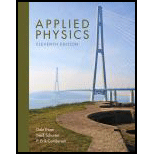
Applied Physics (11th Edition)
11th Edition
ISBN: 9780134159386
Author: Dale Ewen, Neill Schurter, Erik Gundersen
Publisher: PEARSON
expand_more
expand_more
format_list_bulleted
Textbook Question
Chapter 15, Problem 4RP
Some carbon dioxide occupies 45.3 L at 38.5ºC. What is the temperature when the volume is 44.2 L if the pressure is constant?
Expert Solution & Answer
Want to see the full answer?
Check out a sample textbook solution
Students have asked these similar questions
1.0 kg of an ideal gas at normal atmospheric pressure was heated in a 1 m3 container until the temperature was doubled while maintaining the pressure. What is the final volume?
Dry air is 78.1% nitrogen. What is the partial pressure of nitrogen when the atmospheric pressure is 1.01×105 N/m2 ?
Dry air is 78.1% nitrogen. What is the partial pressure of nitrogen when the atmospheric pressure is 1.01 X 105 N/m2?
Chapter 15 Solutions
Applied Physics (11th Edition)
Ch. 15.1 - Change 15C to K.Ch. 15.1 - Prob. 2PCh. 15.1 - Prob. 3PCh. 15.1 - Change 235 K to C.Ch. 15.1 - Prob. 5PCh. 15.1 - Prob. 6PCh. 15.1 - Prob. 7PCh. 15.1 - Change 375R to F.Ch. 15.1 - T=315 K, V=225 cm3, T=275 K, find V.Ch. 15.1 - T=615R, V=60.3 in3, T=455R, find V.
Ch. 15.1 - V=200 ft3, T=95F, V=250 ft3, find T.Ch. 15.1 - Prob. 12PCh. 15.1 - Some gas occupies a volume of 325 m3 at 41 C. What...Ch. 15.1 - Some oxygen occupies 275 in3 at 35C. Find its...Ch. 15.1 - Some methane occupies 1575 L at 45C. Find its...Ch. 15.1 - Some helium occupies 1200ft3 at 70F. At what...Ch. 15.1 - Some nitrogen occupies 14,300 cm3 at 25.6C. What...Ch. 15.1 - Some propane occupies 1270 cm2 at 18.0C. What is...Ch. 15.1 - Some carbon dioxide occupies 34.5 L at 49.0C. Find...Ch. 15.1 - Some oxygen occupies 28.7 ft3 at 11.0F. Find its...Ch. 15.1 - A balloon contains 26.0 L of hydrogen at 40.0F....Ch. 15.1 - Using Charles's law, determine the effect (a) on...Ch. 15.1 - If 38.0 L of hydrogen is heated to 110C and...Ch. 15.1 - Prob. 24PCh. 15.1 - A hot air balloon contains 147 m3 of air at 19.0C....Ch. 15.1 - A tank with 139 L of propane is cooled from 91.0C...Ch. 15.1 - A 2000 L fuel tank filled with propane at 21C is...Ch. 15.1 - A propane nurse tank is left on a job site...Ch. 15.1 - A propane tank now containing 250L of propane was...Ch. 15.1 - A tank with 500 L of propane is heated from 17.0C...Ch. 15.2 - V'=315 cm3, P=101 kPa, P'=85.0 kPa; find V.Ch. 15.2 - V=450L, V'=700L, P=750 kPa; find P'.Ch. 15.2 - V=76.0 m3, V'=139 m3, P'=41.0 kPa; find P.Ch. 15.2 - V=439 in3, P'=38.7 psi, P=47.1 psi; find V'.Ch. 15.2 - D=1.80 kg/m3, P=108 kPa, P'=125 kPa; find D'.Ch. 15.2 - Prob. 6PCh. 15.2 - P=51.0 psi, P'=65.3 psi, D'=0.231 lb/ft3; find D.Ch. 15.2 - Some air at 22.5 psi occupies 1400 in3. What is...Ch. 15.2 - Prob. 9PCh. 15.2 - Prob. 10PCh. 15.2 - Prob. 11PCh. 15.2 - Some oxygen has a density of 1.75 kg/m3 at normal...Ch. 15.2 - Some methane at 500 kPa gauge pressure occupies...Ch. 15.2 - Prob. 14PCh. 15.2 - Some nitrogen at 80.0 psi gauge pressure occupies...Ch. 15.2 - Prob. 16PCh. 15.2 - Prob. 17PCh. 15.2 - Some propane occupies 2.30 m3 at a gauge pressure...Ch. 15.2 - A quantity of oxygen at a gauge pressure of 20.0...Ch. 15.2 - Some air occupies 4.5 m3 at a gauge pressure of 46...Ch. 15.2 - Some oxygen at 87.6 psi (absolute) occupies 75.0...Ch. 15.2 - A gas at 300 kPa (absolute) occupies 40.0 m3. Find...Ch. 15.2 - A volume of 58.0 L of hydrogen is heated from 33C...Ch. 15.2 - Prob. 24PCh. 15.2 - A 2.00-L plastic bottle contains air at a pressure...Ch. 15.2 - Prob. 26PCh. 15.2 - A mass of 1.31 kg of neon is in a 3.00-m3...Ch. 15.2 - The air density in a tractor tire is 1.40 kg/m3 at...Ch. 15.2 - An unknown gas is in a tank at 13.3 kPa. (a) If...Ch. 15.3 - Use Vp=VPto find each quantity. (All pressures are...Ch. 15.3 - Use Vp=VP to find each quantity. (All pressures...Ch. 15.3 - Use Vp=VPto find each quantity. (All pressures are...Ch. 15.3 - Use Vp=VPto find each quantity. (All pressures are...Ch. 15.3 - Use Vp=VP to find each quantity. (All pressures...Ch. 15.3 - We have 600 in3 of oxygen at1500 psi at 65F. What...Ch. 15.3 - We have 800m3 of natural gas at 235 kPa at 30C....Ch. 15.3 - We have 1400 L of nitrogen at 135 kPa at 54C. What...Ch. 15.3 - An acetylene welding tank has a pressure of 2000...Ch. 15.3 - What is the new pressure in Problem 9 if the...Ch. 15.3 - An ideal gas occupies a volume of 5.00 L at STP....Ch. 15.3 - An ideal gas occupies a volume of 5.00 L at STP....Ch. 15.3 - Some propane occupies 2.00 m3 at18.0C at an...Ch. 15.3 - A balloon with volume 3200 mL of xenon gas is at a...Ch. 15.3 - A 7 85-L helium-filled balloon experiences a...Ch. 15 - Prob. 1RQCh. 15 - Prob. 2RQCh. 15 - Prob. 3RQCh. 15 - Prob. 4RQCh. 15 - Prob. 5RQCh. 15 - Prob. 6RQCh. 15 - Prob. 7RQCh. 15 - Prob. 8RQCh. 15 - Prob. 9RQCh. 15 - What causes the tendency of the volume and...Ch. 15 - What causes the tendency of the temperature of a...Ch. 15 - What causes the tendency of the pressure of a gas...Ch. 15 - A gas occupies 13.5 ft3 at 35.8F. What will the...Ch. 15 - A gas occupies 3.45 m3 at 18.5 C. What will the...Ch. 15 - Some hydrogen occupies 115 ft3 at 54.5F. What is...Ch. 15 - Some carbon dioxide occupies 45.3 L at 38.5C. What...Ch. 15 - Some propane occupies 145 cm3 at 12.4 C. What is...Ch. 15 - Some air at 276 kPa occupies 32.4 m3. What is its...Ch. 15 - Some helium at 17.5 psi gauge pressure occupies...Ch. 15 - Prob. 8RPCh. 15 - We have 435 in3 of nitrogen at 1340 psi gauge...Ch. 15 - We have 755 m3 of carbon dioxide at 344 kPa at...Ch. 15 - A welding tank has a gauge pressure of 1950 psi at...Ch. 15 - An ideal gas occupies a volume of 4.50 L at STP....Ch. 15 - An ideal gas occupies a volume of 5.35 L at STP....Ch. 15 - A volume of 1120 L of helium at 4000 Pa is heated...Ch. 15 - In a 47-cm-tall cylinder of radius 7.0 cm,...Ch. 15 - Fran purchases a 1.85-ft3, helium-filled Mylar...Ch. 15 - An automobile tire is filled to an air pressure of...Ch. 15 - A 15.0-cm-long cylinder has a movable piston with...Ch. 15 - A 0.0300-m3 steel tank containing helium is stored...Ch. 15 - A lightweight weather-collecting sensor is...
Additional Science Textbook Solutions
Find more solutions based on key concepts
Interpret This problem involves applying Gauss's law to find the electric flux through a sphere that encloses a...
Essential University Physics (3rd Edition)
Two identical bubbles of gas form at the bottom of a lake, then rise to the surface. Because the pressure is mu...
An Introduction to Thermal Physics
The average upward force exerted by one square meter of ground to stop the falling raindrops during the storm.
Physics (5th Edition)
A string with a linear mass density of 0.0075 kg/m and a length of 6.00 m is set into the n=4 mode of resonance...
University Physics Volume 1
49. A gray kangaroo can bound across level ground with each jump carrying it 10 m from the takeoff point. Typic...
Physics for Scientists and Engineers: A Strategic Approach with Modern Physics (4th Edition)
Why is speciation often associated with the introduction of a geographic barrier?
Conceptual Integrated Science
Knowledge Booster
Learn more about
Need a deep-dive on the concept behind this application? Look no further. Learn more about this topic, physics and related others by exploring similar questions and additional content below.Similar questions
- A rigid tank contains 2500L of Argon gas. The pressure is 3790kPa and the temperature is 25°C. How many miles of Argon are in the tank?arrow_forwardAn Oxygen tank has pressure of 1200.0kpa at 283K. What will the pressure be if the temperature is increased to 387K?arrow_forwardHow many moles of air are in an inflated basketball? Assume the pressure in the ball is 159 kPa,the temperature is 293 K, and the diameter of the ball is 23.0 cm.arrow_forward
- What is gas density, if under pressure of 105 Pa, its molecules move at a speed of 300 m/s? /Give the answer in [kg/m3] /arrow_forwardA tank of helium gas used to inflate toy balloons is at pressure of 15.5 X 10^6 Pa and a temperature of 293 K. The tank's volume is 0.020 m^3. How large a balloon would it fill at 1.00 atmosphere and 323 K?arrow_forwardWhat is the new temperature of a lead ball if the initial temperature is 63°F, and the volume of the ball is increased from 4000 mm3 to 4050 mm3? Take α = 29 x 10-6 /C°.arrow_forward
- 5.26 How many moles of an ideal gas are there if the volume of the gas is 158 L at 14°C and a pressure of 89 kPa?arrow_forwardA container is filled with gas at a temperature of 83.4ºF at standard pressure. If the temperature is decreased to 18.4ºF, what is the final pressure inside of the container in kPa?arrow_forwardA machinist wishes to insert a steel rod with a diameter of 5 mn into a hole with a diameter of 4.997 mm. B how much would the machinist, have to lower the temperature of the rod to make it fit the hole?arrow_forward
- A vessel of volume 2000cm3 contains 0.1mole of oxygen and 0.2 mole of carbon dioxide. If the temperature of the mixture is 300K, find the pressure.arrow_forwardIf 3.95 mol of an ideal gas has a pressure of 2.29 atm and a volume of 78.45 L, what is the temperature of the sample in degrees Celsius? ?=_____ °Carrow_forwardA large cylindrical tank contains 0.00045 m3 of an ideal gas at a temperature of 18ºC and a pressure of 7125 Pa . What will be the gas pressure if the temperature of the gas is increased to 120ºC and the volume is unchanged?arrow_forward
arrow_back_ios
SEE MORE QUESTIONS
arrow_forward_ios
Recommended textbooks for you
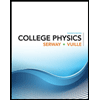 College PhysicsPhysicsISBN:9781305952300Author:Raymond A. Serway, Chris VuillePublisher:Cengage Learning
College PhysicsPhysicsISBN:9781305952300Author:Raymond A. Serway, Chris VuillePublisher:Cengage Learning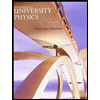 University Physics (14th Edition)PhysicsISBN:9780133969290Author:Hugh D. Young, Roger A. FreedmanPublisher:PEARSON
University Physics (14th Edition)PhysicsISBN:9780133969290Author:Hugh D. Young, Roger A. FreedmanPublisher:PEARSON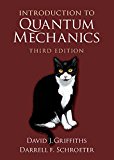 Introduction To Quantum MechanicsPhysicsISBN:9781107189638Author:Griffiths, David J., Schroeter, Darrell F.Publisher:Cambridge University Press
Introduction To Quantum MechanicsPhysicsISBN:9781107189638Author:Griffiths, David J., Schroeter, Darrell F.Publisher:Cambridge University Press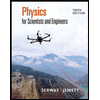 Physics for Scientists and EngineersPhysicsISBN:9781337553278Author:Raymond A. Serway, John W. JewettPublisher:Cengage Learning
Physics for Scientists and EngineersPhysicsISBN:9781337553278Author:Raymond A. Serway, John W. JewettPublisher:Cengage Learning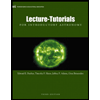 Lecture- Tutorials for Introductory AstronomyPhysicsISBN:9780321820464Author:Edward E. Prather, Tim P. Slater, Jeff P. Adams, Gina BrissendenPublisher:Addison-Wesley
Lecture- Tutorials for Introductory AstronomyPhysicsISBN:9780321820464Author:Edward E. Prather, Tim P. Slater, Jeff P. Adams, Gina BrissendenPublisher:Addison-Wesley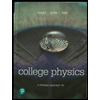 College Physics: A Strategic Approach (4th Editio...PhysicsISBN:9780134609034Author:Randall D. Knight (Professor Emeritus), Brian Jones, Stuart FieldPublisher:PEARSON
College Physics: A Strategic Approach (4th Editio...PhysicsISBN:9780134609034Author:Randall D. Knight (Professor Emeritus), Brian Jones, Stuart FieldPublisher:PEARSON

College Physics
Physics
ISBN:9781305952300
Author:Raymond A. Serway, Chris Vuille
Publisher:Cengage Learning

University Physics (14th Edition)
Physics
ISBN:9780133969290
Author:Hugh D. Young, Roger A. Freedman
Publisher:PEARSON

Introduction To Quantum Mechanics
Physics
ISBN:9781107189638
Author:Griffiths, David J., Schroeter, Darrell F.
Publisher:Cambridge University Press

Physics for Scientists and Engineers
Physics
ISBN:9781337553278
Author:Raymond A. Serway, John W. Jewett
Publisher:Cengage Learning

Lecture- Tutorials for Introductory Astronomy
Physics
ISBN:9780321820464
Author:Edward E. Prather, Tim P. Slater, Jeff P. Adams, Gina Brissenden
Publisher:Addison-Wesley

College Physics: A Strategic Approach (4th Editio...
Physics
ISBN:9780134609034
Author:Randall D. Knight (Professor Emeritus), Brian Jones, Stuart Field
Publisher:PEARSON
Thermal Expansion and Contraction of Solids, Liquids and Gases; Author: Knowledge Platform;https://www.youtube.com/watch?v=9UtfegG4DU8;License: Standard YouTube License, CC-BY